How To Get Rid Of Static Noise In Car Speakers
Car audio noise suppression guide
Diagnosing and treating racket problems in your car audio system
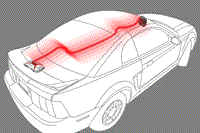
This guide will help you diagnose and treat bug with extraneous dissonance in your motorcar audio arrangement.
Dealing with static, whining, and buzzing
You've installed a new receiver or amplifier in your auto, and now yous have a noise problem. Noise in your audio system usually comes in these three forms:
- Radio static
- Amplifier whine
- Buzzing speakers
What can you do? The trick is to determine what the source of the racket is. Noise tin be introduced into your organisation from a number of sources. This is especially truthful if yous have an amplifier. The type of noise you're hearing tin help determine the cause.
Read over this article for some hints and explanations of what can cause noise in your organization. Use it as a checklist, eliminating possibilities until you observe the culprit. You lot can also use this diagnostic flowchart every bit a guide to walk yous through the troubleshooting process.
And don't forget – if you purchased your gear from Crutchfield, don't hesitate to phone call on our tech support team (have your Crutchfield invoice handy).
Noise and your new receiver
If you've just installed a new receiver, here are two quick and easy starting points:
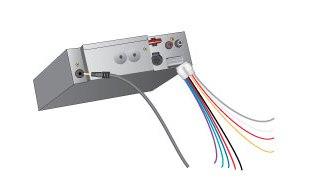
Racket in your receiver is often due to a poor ground wire connection or a poorly grounded antenna.
Is your receiver securely grounded?
Improper ground is 1 of the biggest causes for introducing noise into your audio system. Is the basis wire located nearly a dissonance source (like a heater, air conditioner, or reckoner)? Is the footing wire actually continued to the vehicle's ground? Since the antenna pb can act as a ground (thereby enabling a new receiver to operate without its ground wire properly continued), the antenna atomic number 82 is frequently the source of noise issues.
Radio static can be caused by antenna dissonance
Check to encounter if you're getting noise on all sources — CD, auxiliary/USB, AM, and FM.
If the racket is present merely on the radio, and then it'southward nigh likely coming through your antenna lead.
Unplug the antenna. If the racket goes away, try an antenna noise suppressor (like American International's AS100). This filter plugs in-line between your receiver and your antenna, breaking the ground path betwixt them, thus preventing dissonance from entering your system.
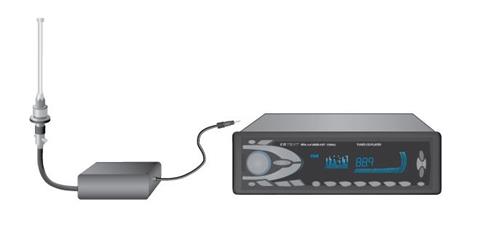
An antenna filter, installed between the vehicle's antenna and the receiver, can minimize dissonance entering your organization from a poorly grounded antenna.
Radiated racket
If the noise isn't coming in through the antenna, try pulling the receiver from the dash while a CD is playing. If the noise goes away, information technology's being radiated into your organisation due to the receiver'south proximity to a noise producer (like a heater motor or car reckoner). This is often referred to equally "sideway noise."
If the noise-causing accompaniment has a motor, a source dissonance filter tin exist installed on the accessory's ability lead to minimize radiated racket. If the auto computer (or other motor-less accessory) is causing the trouble, motility your receiver's wiring away from that accessory to minimize the radiated noise.
Try using magnetic shielding foil (also called Mu-metal) to shield the dorsum of the receiver or wrap the wire or component that's radiating the noise into your system.
Engine racket and alternator whine
Noise introduced through the power and footing wires connected to your receiver is called engine noise or alternator whine. If engine noise is your culprit, y'all may hear a whining or clicking sound. Its pitch will usually vary with engine speed.
If this is the instance, you can install an alternator noise filter on the power line between the battery and the alternator to minimize the problem. You can also install a dissonance filter on the receiver's power lead to cut downwardly on signal pollution (American International's S15A (15-amp, 250-watt) or S25A (25-amp, 350-watt) filters, for example). About oft, nevertheless, alternator noise comes from a loose or intermittent ground connection. See the section below most noise in the electrical system.
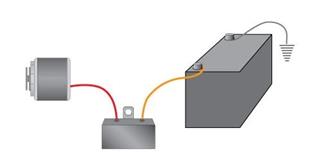
An alternator noise suppressor connects inline between the alternator and battery, and tin can reduce loftier-pitched whining noise that modulates co-ordinate to engine RPMs.
Noise and your new amplifier
An amplifier can introduce noise into your system through a bad footing or through a poor mounting. Rubber grommets or feet can help isolate the amplifier from the chassis of the vehicle, a potential source of dissonance. If all else fails, install a racket suppressor. The catchy office is figuring out which stride or steps to have. Please read the rest of this section and try some of the simple tests.
Where is the amp mounted?
Is it near something that could be radiating racket, like a rear-mounted tuner or estimator? If so, unbolt it and move it abroad to see if the noise stops. Remove your patch cables. If you lot notwithstanding hear racket, check to encounter if your amp is isolated from the vehicle's chassis. Any contact betwixt your amp'southward metallic casing and your vehicle'southward body could cause noise bug.
Bank check your ground wire
Is information technology securely fastened to the vehicle's chassis with a adept contact to clean metal? Your footing wire should ideally be 18" long at most — a longer footing wire can cause racket problems. Improper grounding causes about system noise bug.
Check your gain structure
If you have an external amplifier in your organization, the outset matter to practice is to quiet any arrangement noise, which sounds similar a constant, depression hiss. Starting time, check for system noise with the engine off. Insert a CD and put your CD player on pause. Listen to the system with the volume style down, then mode up. Put on music. If yous hear hiss or static in either instance, reduce the gain on your amplifier.
Pass more than signal from the receiver to the amp by leaving the receiver's volume college before y'all set the amp's proceeds. Experiment until y'all eliminate the hiss or reduce it as much as possible. A tiny bit of hiss is okay — you won't hear it while driving.
Noise in the patch cables
Noise can be picked up past the RCA patch cables connecting your components. To test this, detach the cables from your amp. Insert ane side (left or right) of a spare patch cable into the amp'southward left and right input jacks (see illustration below). Plow on your system and engine.
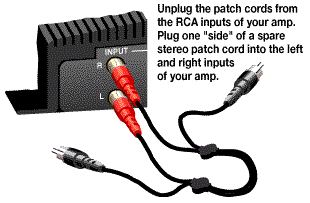
If the noise is gone, reconnect the cables to the amp, and disconnect them from your receiver. If you hear the dissonance, your patch cables are definitely picking information technology up. Try re-routing them. Separate them from your ability cable by at least xviii inches. You could try a better brand of patch cables. The inexpensive RCA cables many people apply to connect their components don't have the insulation or conductivity necessary to deflect noise in a metal, highly conductive motorcar.
How much noise your cable receives depends largely on the size of its "loop area" — the larger the loop area, the more vulnerable your cable is to induced interference. A cable'due south loop surface area is equal to the distance between its middle conductor and outer shield times the length of ane complete twist in a twisted pair configuration, or the entire length of the cable in a coaxial type. Consider trading your sometime cable for i with a twisted pair design. You'll get a smaller loop area and less dissonance.
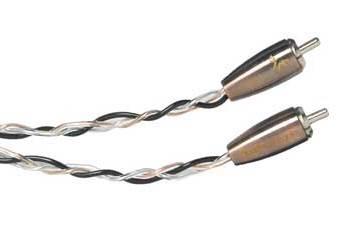
Patch cables with a "twisted pair" blueprint help reject noise
Equally a concluding resort, a footing loop isolator (like PAC's SNI-1) can exist installed between the receiver's preamp outputs and your amp to minimize this problem.
Dissonance and whine picked up by the power or ground cables
We discussed ground cables above, because that'south the cause of noise more often than non. If the noise wasn't due to a poor ground or through the stereo'south antenna cablevision, it may be coming in through the amplifier's main power cablevision. Noise tin can be created past cable of insufficient gauge, and then you might endeavour thicker cable.
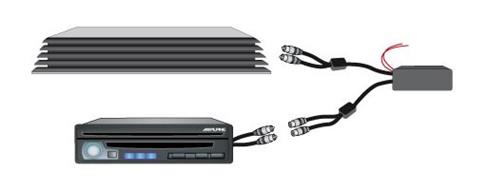
If you cannot find the faulty ground in your multi-amp system, a ground loop isolator tin help minimize the problem.
Multiple amplifiers can too create ground loop problems, which can commonly be solved by grounding each amplifier with its ain dissever wire. If you are unable to locate the cause, a footing loop isolator (like PAC'due south SNI-1) tin can be installed between the receiver's preamp outputs and the amplifiers to minimize this problem.
Noise in speaker wiring
Noise can likewise come in through the speaker wires. To examination them, turn the organisation off and disconnect the speaker wires from the amps. Now first the car. If the noise is still there, then it's being radiated into the speaker wires. Reposition them, or, equally a last resort, shield them past wrapping them with Mu-metal foil.
Noise from the electrical system
If you lot've tried all of the noise-fighting tips higher up and y'all're still getting static, whine, or hiss, then the problem might be with your vehicle. Y'all might only need to fill your battery with fluid. If that doesn't help, have a mechanic check your alternator and battery.
If your car is older and hasn't been tuned up recently, yous may take ignition dissonance. It'south a ticking noise that varies in speed as you accelerate. Y'all may need a tune-up involving resistor-blazon spark plugs, shielded carbon-core spark plug wires, distributor cap, and coil.
If the racket doesn't disappear, so your ignition organization may not be grounded well enough and is broadcasting ticks to other items such as your air cleaner, hood, exhaust system, etc. Chances are, grounding ane of the under-hood components will eliminate the noise. With your sound system on and the car running, effort grounding each of these different components of the car. Information technology'south possible that grounding 1 of your car's components will eliminate the noise. If so, make the footing permanent with a braided ground strap.
A very effective set for electrical organisation noise is called "The Big Three" upgrade. This is where your vehicle'south battery charging wire and chassis ground wires are augmented by calculation large estimate wires (ane/0- or 4-ga.) to those connecting the alternator to the bombardment's positive pole, the battery'due south negative pole to the chassis, and the chassis to the engine block. This establishes ameliorate electric current flow and more than consistent voltage, which improves your system's signal to racket ratio. It likewise ensures against loose or restrictive ground connections, which, as said earlier, are common sources of racket. Read our article well-nigh The Large Iii for more data.
Racket and your nervous system
Noise issues can be very frustrating, specially when you lot can't wait to hear your new equipment. It helps to remember that you've only placed a very sophisticated piece of electronic gear (a new receiver or amplifier) in the middle of an extremely complex system — your vehicle's electrical wiring. Dissonance is just nature's way of telling you that something'due south out of whack. Merely run down the listing, eliminating possible dissonance sources until yous discover the problem.
Crutchfield Tech Support
If you lot bought your gear from Crutchfield, y'all could call Tech Support for gratis help troubleshooting your organization. The cost-free number is on your invoice.
How To Get Rid Of Static Noise In Car Speakers,
Source: https://www.crutchfield.com/ISEO-rgbtcspd/learn/learningcenter/car/noise_suppressors_installation_guide.html
Posted by: tierneywevere.blogspot.com


0 Response to "How To Get Rid Of Static Noise In Car Speakers"
Post a Comment